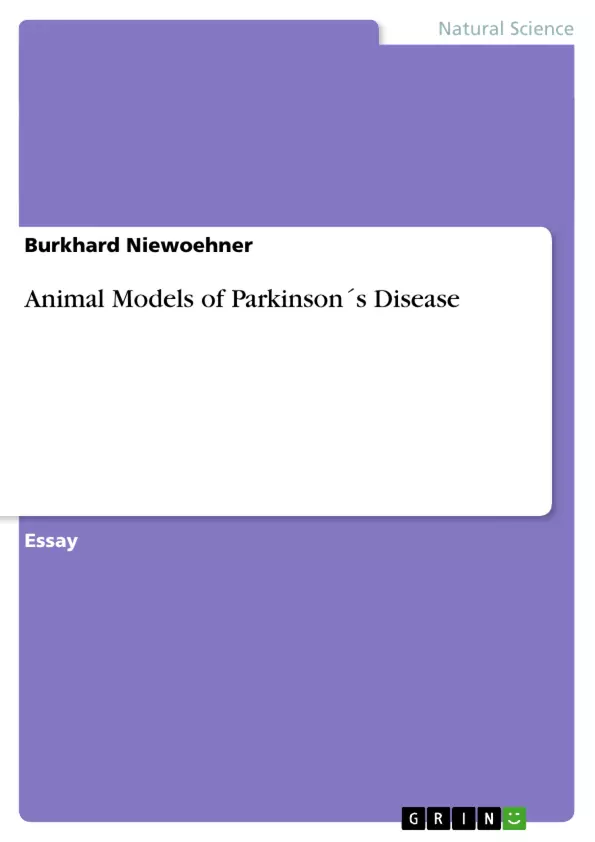Parkinson’s disease (PD) was the first neurological disease to b e modelled in animals. Early models of PD used toxins which selectively targeted dopaminergic neurons, such as reserpine, 6 -hydroxydopamine, and 1 -methyl-4-phenyl-1,2,3,6tetrahydropyridine. These initial models have greatly contributed to the current understanding of the pathogenesis of PD and have proven to be valuable tools in the development of novel therapeutic approaches, but have failed to mimic important characteristics of PD. Recently, it has been found that chronic systemic exposure to the pesticide rotenone can reproduce specific features of PD in rodents. Moreover, the association of a-synuclein mutations with some cases of familial PD have motivated the development of genetic models of PD in mice and Drosophila. The present essay gives a brief survey of the clinics and pathophysiology of PD, discusses the different animal models of PD currently available, and briefly compares the suitability the rodents and primates as models for human PD.
Inhaltsverzeichnis (Table of Contents)
- Introduction
- Parkinson's disease
- Clinical presentation
- Pathophysiology
- Aetiology
- Animal models of Parkinson's disease: General considerations
- Why use animal models?
- The ideal animal model of PD
- Animal models of PD
- Toxins
- Reserpine
- 6-hydroxydopamine
- MPTP
- Rotenone
- Genetic models
- a-synuclein
- Parkin
- UCH-L1
Zielsetzung und Themenschwerpunkte (Objectives and Key Themes)
This essay provides a comprehensive overview of Parkinson's disease, its underlying mechanisms, and the various animal models employed in research. The essay delves into the clinical features, pathophysiology, and potential causes of Parkinson's disease. It then explores different animal models, including toxin-induced and genetically modified models, analyzing their strengths and limitations in mimicking human disease.
- Clinical presentation of Parkinson's disease
- Pathophysiology of Parkinson's disease, including the role of dopamine neurons and Lewy bodies
- Aetiology of Parkinson's disease, examining both environmental and genetic factors
- The utility of animal models in Parkinson's disease research
- The development and characteristics of various animal models of Parkinson's disease, including toxin-induced and genetic models
Zusammenfassung der Kapitel (Chapter Summaries)
- Introduction: This chapter sets the stage for the essay, outlining the significance of animal models in Parkinson's disease research. It highlights the historical development of such models, from early toxin-induced models to more recent genetically modified models.
- Parkinson's disease: This chapter provides a detailed account of Parkinson's disease, encompassing its clinical manifestations, pathophysiology, and potential causes. It describes the progressive degeneration of dopaminergic neurons, the formation of Lewy bodies, and the role of environmental and genetic factors in the disease.
- Animal models of Parkinson's disease: General considerations: This chapter discusses the importance of animal models in understanding the pathogenesis of Parkinson's disease and developing novel therapeutic strategies. It outlines the features of an ideal animal model, aiming to closely mimic the human disease.
Schlüsselwörter (Keywords)
Parkinson's disease, animal models, dopaminergic neurons, Lewy bodies, toxins, 6-hydroxydopamine, MPTP, rotenone, genetic models, a-synuclein, parkinsonian motor symptomatology, therapeutic approaches, neurodegeneration.
- Quote paper
- PhD Burkhard Niewoehner (Author), 2003, Animal Models of Parkinson´s Disease, Munich, GRIN Verlag, https://www.grin.com/document/48123



